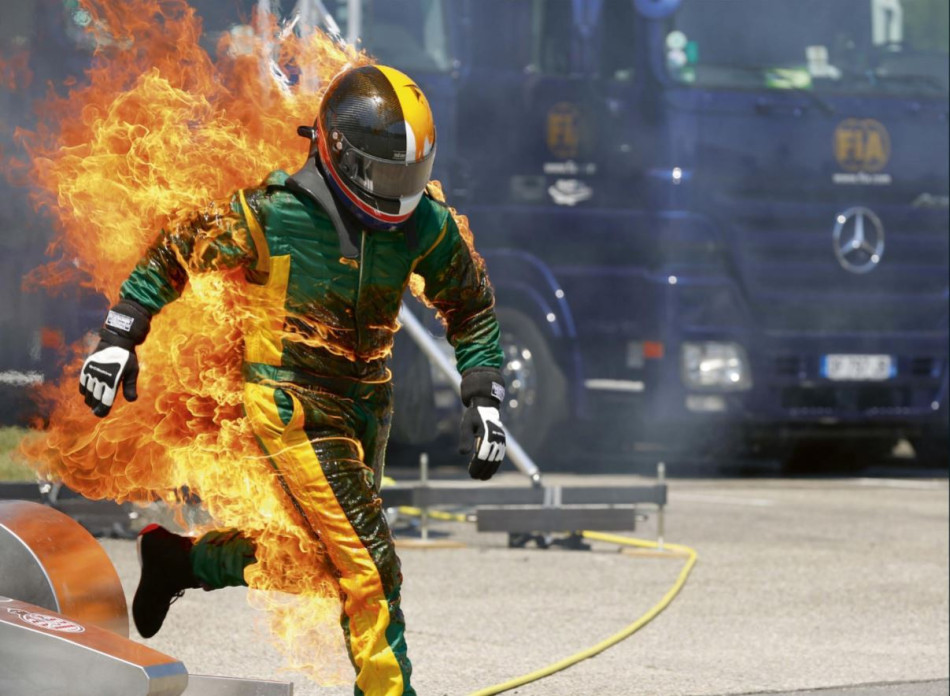Strong Suit - AUTO Magazine
From next season, all drivers in top-level championships must wear new high-tech racesuits that meet the FIA's toughest-ever Protective Clothing Standard

From 2020, all drivers in Formula E (Season 6), Formula One, the World Rally Championship (Priority 1 driver and co-driver) and World Endurance Championship (season 2020-21) will have to pay more attention to what they wear.
The FIA has released a new Protective Clothing Standard (8856-2018) which will be mandatory for drivers in those championships, and for Formula 2, World Rallycross and the FIA World Cup for Cross Country events from 2021.
This means that drivers can only wear clothing – race suits, underwear, gloves, shoes – that have passed new stringent tests.
Light Years Ahead
These latest developments in protective clothing have been almost 20 years in the making, with the new standard developed by the FIA alongside leading racewear manufacturers to ensure the highest levels of safety.
In previous years, drivers would wear heavy suits, but in recent years they have moved to more advanced materials such as Nomex – a lightweight artificial fibre solution. These used to be homologated under the 8856-2000 standard, published 18 years ago, but the new update has necessitated a major upgrade in all racewear.
The new FIA Standard 8856-2018 offers several advances by enhancing the tests that each piece of clothing must pass. One major improvement has been to what is called Heat Transfer Index (HTI), which has increased by 20 per cent. Nuno Costa, the FIA’s Head of Competitor Safety, says this was key when transitioning from the previous standard, to help protect drivers against direct flames and second-degree burns.
“The problem we had with the previous standard is that while we were doing heat transmission on the overalls and gloves, for underwear, balaclavas, socks and shoes we only had a requirement with the density of the material,” explains Costa. “Along the years the drivers started to wear materials better adjusted to the body for comfort, so density was not relevant anymore.”
The move away from using dense materials in favour of slim-fitting race suits is partially down to drivers wanting to save on weight in the car. In F1, racewear manufacturer Puma developed a new, lighter and disposable race suit that weighs just 650g, while Lewis Hamilton has been known to ask racewear manufacturers to take the seams out of his race underwear to save 10g.
Underwear has been a key focus for the new standard because it is now part of the heat transmission test, which means it has to meet a whole new set of requirements.
“What we decided to do for the new standard is to introduce a new heat transmitting test on underwear,” says Costa. “We are stretching the materials to represent the way vests and pants are being worn by the drivers in the car. So even if the driver wears a material that is stretched we can still ensure that we are giving the right protection.”
This has made the new underwear standards particularly difficult to pass as it involves testing heat transmission under stretching while the garment has a flame applied to it for a minimum of five seconds to achieve a temperature rise of 24°C.
Challenging Environments
The strict design requirements that each manufacturer must adhere to are part of what makes the standard rigorous, which is why each piece of protective clothing is subjected to these tests. The HTI test stipulates that a driver’s suit must withstand a direct flame for a minimum of 12 seconds, while the underwear, socks and balaclava must withstand a minimum of five seconds, the shoes 11 seconds, and the gloves 11 seconds with exception of the palm which must withstand eight seconds.
This has proved a major challenge for the manufacturers. Nico Buzzatti, Quality Manager
at racewear manufacturer Alpinestars, explains: “The HTI test on the drivers’ suits was the most challenging of the tests we experienced. We had to ensure that the suit was able to meet the more rigorous standard while still keeping the same low weight, by continuing to develop new materials, and ensuring that they still delivered the same high levels of breathability for which we are known.”
Modern race suits are light and breathable to improve the comfort and safety of drivers in the car. The dilemma was how to maintain this while meeting the new tougher standards.
“If the overalls are too thick the drivers may start getting fatigued because of the lower breathability level of the garment,” explains Costa. “That is why comfort is so important, the overalls need to be still wearable for the type of events that we have in FIA championships.”
As racing drivers are competing at high speed in a precision environment they can often feel even the slightest bit of discomfort in the cockpit. This is why Alpinestars works with drivers to provide bespoke clothing to manage this.
These demands can be slightly different for rally drivers because they often work on the car during stages, spending a large amount of time leaning over or even laying on the floor which can be a rough and dirty surface.
“The main focus for Alpinestars is to ensure that a suit will be as flexible as possible for rally drivers,” says Buzzatti. “Our WRC suits feature extensive stretch panels on the lower back, crotch and knee area for optimal levels of comfort.”
Manufacturers have already homologated a number of products to the new standards with the FIA. Alpinestars was the first manufacturer to have passed the tests for all of its pro-level products, but the other manufacturers are not far behind. With the new Formula E season starting imminently, and all drivers having to abide by the new standards, the race is on to meet them.

 Facebook
Facebook Twitter
Twitter






